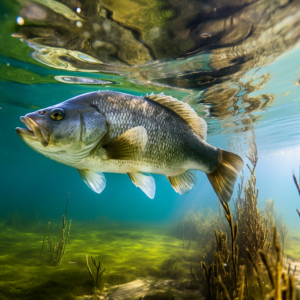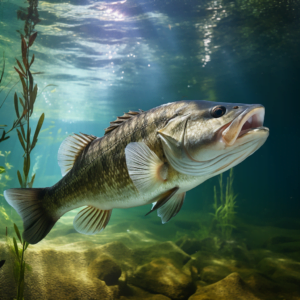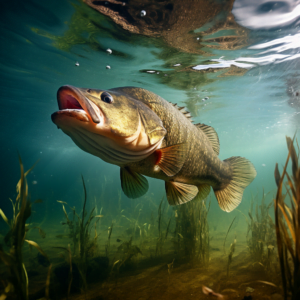Have you ever wondered why bass seem to be so uninterested in biting during the summer? It’s a common frustration among anglers, especially those who are used to the excitement of reeling in a big catch. But fear not, because we’re about to dive into the mystery of why bass avoid biting during the summer months.
One possible reason for this phenomenon is the rise in water temperature. As the weather gets hotter, the water in lakes and rivers begins to warm up as well. This increase in temperature can make bass less active and more sluggish, affecting their appetite. Additionally, the warmer water can lead to a decrease in oxygen levels, which further deters bass from feeding.
Another factor that could contribute to the reduced biting activity of bass in the summer is the abundance of natural food sources. During this time of year, there is usually an abundance of insects, small fish, and other prey in the water, providing bass with an easy and ample food supply. With so much readily available food around them, bass may simply not feel the need to chase after bait or lures from anglers.
In our upcoming article, we’ll delve deeper into these reasons and explore additional factors that may influence bass behavior in the summer. So, stay tuned as we uncover the secrets behind why bass avoid biting during this season and discover strategies to increase your chances of a successful summer fishing trip.
Introduction
Summertime is the perfect opportunity to head out to the lake, cast a line, and enjoy a day of fishing. However, any experienced angler knows that during the warmer months, bass tend to be less active and less inclined to bite. This phenomenon has puzzled fishermen for decades, leading to the question: Why do bass avoid biting in the summer? In this article, we will dive deep into the world of bass behavior, exploring their feeding habits, the factors that influence their biting, and how they change during the summer months. By understanding these concepts, you’ll be better equipped to tackle the summer mystery and increase your chances of a successful bass fishing trip.
Understanding Bass Behavior
Bass Feeding Habits
To comprehend why bass are less likely to bite in the summer, it’s crucial to understand their feeding habits. Bass are known to be predatory fish that primarily feed on other fish, insects, and crustaceans. They exhibit an opportunistic feeding behavior, ambushing their prey and striking in a split second. This behavior is heavily influenced by various factors, including water temperature, dissolved oxygen levels, and the availability of prey.
Factors Influencing Bass Biting
Several factors come into play when it comes to bass biting. Water temperature is one of the primary influencers, as bass are cold-blooded creatures and rely on environmental cues to determine their activity level. As the water temperature rises during the summer, bass become more sluggish and less motivated to chase after food. Additionally, dissolved oxygen levels play a crucial role in bass behavior. Lower oxygen levels in warm water can make bass less active and less inclined to feed. Lastly, the availability of prey also affects bass biting. During the summer, the abundance of prey species can change, leading to a shift in the bass’s dietary preferences.
Changes in Bass Behavior During Summer
As the temperature rises and summer sets in, bass undergo several changes in their behavior. They tend to move to deeper and cooler areas of the water, seeking relief from the heat. This shift in habitat can make it more challenging for anglers to locate and target bass. Furthermore, the heat and sunlight have a significant impact on their feeding patterns, which we will explore in more detail.
Environmental Factors
Water Temperature
Water temperature plays a crucial role in bass behavior, especially during the summer months. As the temperature rises, bass tend to become less active and seek out cooler areas of the water. This is because bass are ectothermic, meaning they rely on external heat sources to regulate their body temperature. When the water temperature exceeds their optimal range, their metabolism slows down, reducing their energy levels and diminishing their desire to feed.
Dissolved Oxygen Levels
Another vital environmental factor that affects bass behavior is the level of dissolved oxygen in the water. Warm water holds less dissolved oxygen, and this can have a significant impact on bass activity. When oxygen levels are low, bass may become lethargic and less inclined to expend energy on feeding. This is particularly true during the summer months when high temperatures can lead to reduced oxygen levels in the water.
Availability of Prey
The availability of prey species also influences bass biting behavior. During the summer months, the abundance and distribution of prey can change, causing bass to alter their feeding habits. For example, certain fish species may migrate to deeper waters or seek shelter in vegetation, making them less accessible to bass. As a result, bass may adjust their diet to target different prey species or even reduce their feeding activity altogether.
Effect of Heat and Sunlight
Impact of High Temperatures on Bass
High temperatures can have significant effects on bass behavior. As summer temperatures soar, bass tend to seek refuge in deeper, cooler waters. This behavior is an adaptive response to maintain their optimal body temperature and conserve energy. In these deeper areas, bass may become less active and less inclined to bite. Therefore, anglers must adjust their fishing techniques and target these specific areas to increase their chances of a successful catch.
The Role of Sunlight in Bass Feeding Patterns
Sunlight also plays a crucial role in bass feeding patterns. Just like humans, bass are sensitive to light and may adjust their behavior accordingly. During the summer, when daylight hours are longer, bass may become more active during early morning and late evening when the sun’s intensity is lower. This behavior is commonly known as crepuscular activity, and it presents anglers with ideal opportunities to catch bass during the cooler parts of the day.
Seasonal Prey Patterns
Shift in Prey Species During Summer
The summer season brings about changes in the availability of prey species, which directly affects bass feeding patterns. For example, certain fish species may spawn during the summer months, leading to an abundance of smaller fish in the water. This availability of easy targets may cause bass to focus their feeding efforts on these newly hatched fish, making them less inclined to bite other types of bait. Therefore, understanding the seasonal prey patterns can help anglers select the most effective bait and increase their chances of success.
Bass Dietary Preferences
In addition to the changes in prey availability, bass also have specific dietary preferences that may vary during the summer months. While bass are opportunistic feeders, they tend to be more selective in their food choices during certain times of the year. For example, during the summer, bass may show a preference for smaller baitfish, insects, or even topwater prey. By understanding their dietary preferences, anglers can tailor their fishing techniques and bait selection to match the bass’s preferred prey, increasing the likelihood of a successful catch.
Fishing Techniques for Summer Bass
Topwater Lures
During the summer months, when bass are less active and less inclined to chase bait, using topwater lures can be an effective technique. Topwater lures imitate prey that is on or near the water’s surface, such as insects or small fish. The action and noise created by these lures can attract the attention of bass, enticing them to strike. This technique is particularly effective during low-light conditions, such as early morning or late evening when bass are more likely to be actively feeding.
Deepwater Fishing Strategies
Since bass tend to seek refuge in deeper, cooler waters during the summer, adopting deepwater fishing strategies can also increase your chances of success. This involves targeting areas with deeper depths, such as drop-offs, ledges, or submerged structures like fallen trees or underwater rock formations. Using techniques such as jigging or Texas rigging can effectively present bait at the desired depth and entice bass to bite.
Using Live Bait Effectively
Live bait can be a great option for summer bass fishing, as it provides a realistic and enticing meal for bass. When using live bait, it’s important to consider the water temperature and the bass’s feeding habits. For example, during hot summer days, bass may be less active and less inclined to chase fast-moving prey. Therefore, choosing live bait that moves naturally in the water, such as live minnows or nightcrawlers, can increase your chances of attracting bass and enticing them to bite.
The Importance of Patience
Adapting to Slower Bass Activity
Bass fishing in the summer requires patience and adaptability. Due to the factors discussed earlier, bass tend to be less active and less inclined to bite. As an angler, adjusting your mindset and embracing the slower pace of summer bass fishing is crucial. Accept that you may not experience the same level of action as during other seasons, but understand that the challenge can be just as rewarding.
Waiting for Optimal Feeding Windows
While bass may be less active overall during the summer, there are still optimal feeding windows that avid anglers can take advantage of. As mentioned earlier, dawn and dusk are prime times for bass feeding activity. Additionally, other factors, such as changes in weather conditions or moon phases, can influence bass behavior and trigger feeding frenzies. By closely monitoring these variables and fishing during these optimal windows, you can significantly increase your chances of hooking into summer bass.
Other Factors to Consider
Residual Effects of Spawning
During the summer, bass can experience residual effects from the spawning season, which may impact their feeding behavior. After the intense activity of spawning, bass may exhibit a period of recovery and reduced feeding activity. This can contribute to their reluctance to bite during the summer months. It is essential for anglers to consider the timing and potential residual effects of spawning when planning their summer bass fishing trips.
Water Clarity and Visibility
Water clarity and visibility are additional factors that can influence bass biting behavior. Clear water can make bass more cautious and less likely to strike. On the other hand, murky or stained water can provide better cover for bass, making them more aggressive and more likely to bite. Understanding the conditions of the water you are fishing in and adjusting your bait selection and fishing techniques accordingly can greatly enhance your chances of success.
Human Activity Disturbance
Human activity and disturbance can also have a significant impact on bass behavior. Areas that are heavily frequented by boaters or anglers can disrupt the peace and quiet that bass prefer. Therefore, targeting less crowded fishing spots or practicing stealthy approaches can help minimize disturbances and increase your chances of encountering more active and willing bass.
Tips for Successful Summer Bass Fishing
Choosing the Right Fishing Spot
When targeting bass during the summer, it’s essential to choose the right fishing spot. Look for areas with deeper water, such as drop-offs or ledges, as bass often seek refuge in these cooler areas. Additionally, areas with vegetation or submerged structures, like fallen trees or rock formations, can provide cover and attract bass. By paying attention to these features and adapting your fishing strategy accordingly, you can increase the likelihood of encountering more active bass.
Optimal Fishing Times
As mentioned earlier, dawn and dusk are optimal times for bass feeding activity during the summer months. Therefore, planning your fishing trips around these times can greatly increase your chances of success. Moreover, monitoring weather conditions, moon phases, and other factors that may influence bass behavior can help you identify additional feeding windows and make the most out of your fishing experience.
Using Appropriate Fishing Gear
Using appropriate fishing gear is crucial for summer bass fishing. Since bass tend to seek deeper areas during this season, it’s essential to have gear that allows you to effectively reach those depths. Consider using medium to medium-heavy spinning or casting rods paired with a suitable reel and line. Additionally, adjusting your tackle to match the size and type of bait you are using can significantly improve your chances of attracting bass and enticing them to bite.
Conclusion
Exploring the summer mystery of why bass avoid biting has provided us with valuable insights into their behavior and the factors that influence their feeding patterns. Understanding bass feeding habits, environmental factors, the role of heat and sunlight, seasonal prey patterns, and effective fishing techniques can greatly enhance your success as an angler. Remember to adapt to the slower pace of summer bass fishing, be patient, and take advantage of the optimal feeding windows. With these tips and tricks in mind, you’ll be well-equipped to unravel the summer mystery and increase your chances of a successful bass fishing adventure. So grab your gear, head out to the water, and embrace the challenge of summer bass fishing.




